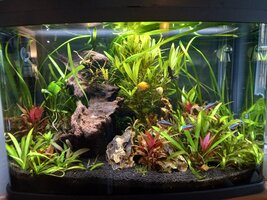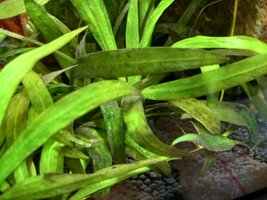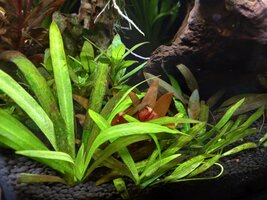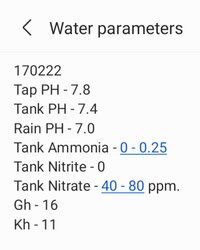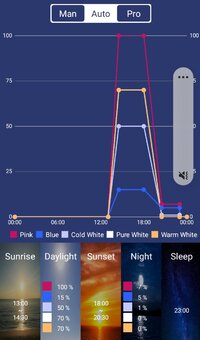WiggyH
New Member
Hello All, help and advice required.
Having invested significant finances (in my opinion) last year, my tank has now been running for over 2 months.
Although many plants are growing well, I'm struggled to get the bright green colouring from my plants. All appears a bit pale, and then gradually gets covered in BBA.
As a summary of my tank, it is a 64L unit, filtered by Biomaster 250 thermo (2 of the 3) sponges removed to replace with Seachem Matrix. Lighting is provided by a Fluval Plant 3.0 (needed this unit to fit under the existing hood), see image for lighting parameters.
Co2 injection is running through an In-line diffuser. Bubbles at 1 per 2 seconds, co2 checker is showing green through lighting period. Liquid feed is Evolution Aqua dosed 2ml per day, and supplemented by JBL Feropol 15ml after each weekly water change. Substrate is tropica soil.
50 % changes per week.
As far a livestock, 6 cardinals, 2 honey gourami, 1 female beta, 3 Wood shrimp, 4 amano, 4 Nitrite snails.
My plants all started off nice bright green, but have gradually gone more pale,yellowing and brown. Any low laying carpeting has just died back and only the smallest piece of Eleocharis remains from 2 pots (looking sad, yellowy brown). Monte Carlo did the same and now all gone.
Anubias is a good dark green, but gets covered in BBA and has to have leaves removed as is too dense to scrub off. Vallisneria and crypts are the same.
Helanthium is pale, then get the same BBA cover. Hygrophilia pinnatifida started a deep red, but is now pale green.
Thinking it was a fertiliser issue, any increase drastically increases the BBA and Green spot algae takes over the bogwood and dragon stone. The bogwood looks okay in the image (just taken) but I had to take it out yesterday for a proper scrub. Maintenance is taking a while with lots to trimming of overly affected leaves, scrubbing etc. Images are taken 2 days after maintenance.
Reading various sources, BBA and algae could be down to fluctuating co2, but that is stable.
Having a chat with a local fish store owner, who has a planted display tank, looking very green and well established he has suggested using RO water as the water in our area (Berkshire) is very hard.
Doing water checks yesterday revealed my current tank levels. (See attached). None of which (to my limited understanding) seem too bad.
Sat for many hours last night, I could not make out if introducing RO (or rain water) to reduce Ph would make a beneficial difference. May seem to find tap water fine for growing plants.
Should I bother trying to change my water parameters with RO or Rainwater to soften to promote plant growth, or am I barking up the wrong tree, and likely to harm the live stock.
Is there something else I should consider to promote greening and prevent algae taking over.
Over to you clever people.
Thanks.
Having invested significant finances (in my opinion) last year, my tank has now been running for over 2 months.
Although many plants are growing well, I'm struggled to get the bright green colouring from my plants. All appears a bit pale, and then gradually gets covered in BBA.
As a summary of my tank, it is a 64L unit, filtered by Biomaster 250 thermo (2 of the 3) sponges removed to replace with Seachem Matrix. Lighting is provided by a Fluval Plant 3.0 (needed this unit to fit under the existing hood), see image for lighting parameters.
Co2 injection is running through an In-line diffuser. Bubbles at 1 per 2 seconds, co2 checker is showing green through lighting period. Liquid feed is Evolution Aqua dosed 2ml per day, and supplemented by JBL Feropol 15ml after each weekly water change. Substrate is tropica soil.
50 % changes per week.
As far a livestock, 6 cardinals, 2 honey gourami, 1 female beta, 3 Wood shrimp, 4 amano, 4 Nitrite snails.
My plants all started off nice bright green, but have gradually gone more pale,yellowing and brown. Any low laying carpeting has just died back and only the smallest piece of Eleocharis remains from 2 pots (looking sad, yellowy brown). Monte Carlo did the same and now all gone.
Anubias is a good dark green, but gets covered in BBA and has to have leaves removed as is too dense to scrub off. Vallisneria and crypts are the same.
Helanthium is pale, then get the same BBA cover. Hygrophilia pinnatifida started a deep red, but is now pale green.
Thinking it was a fertiliser issue, any increase drastically increases the BBA and Green spot algae takes over the bogwood and dragon stone. The bogwood looks okay in the image (just taken) but I had to take it out yesterday for a proper scrub. Maintenance is taking a while with lots to trimming of overly affected leaves, scrubbing etc. Images are taken 2 days after maintenance.
Reading various sources, BBA and algae could be down to fluctuating co2, but that is stable.
Having a chat with a local fish store owner, who has a planted display tank, looking very green and well established he has suggested using RO water as the water in our area (Berkshire) is very hard.
Doing water checks yesterday revealed my current tank levels. (See attached). None of which (to my limited understanding) seem too bad.
Sat for many hours last night, I could not make out if introducing RO (or rain water) to reduce Ph would make a beneficial difference. May seem to find tap water fine for growing plants.
Should I bother trying to change my water parameters with RO or Rainwater to soften to promote plant growth, or am I barking up the wrong tree, and likely to harm the live stock.
Is there something else I should consider to promote greening and prevent algae taking over.
Over to you clever people.
Thanks.


